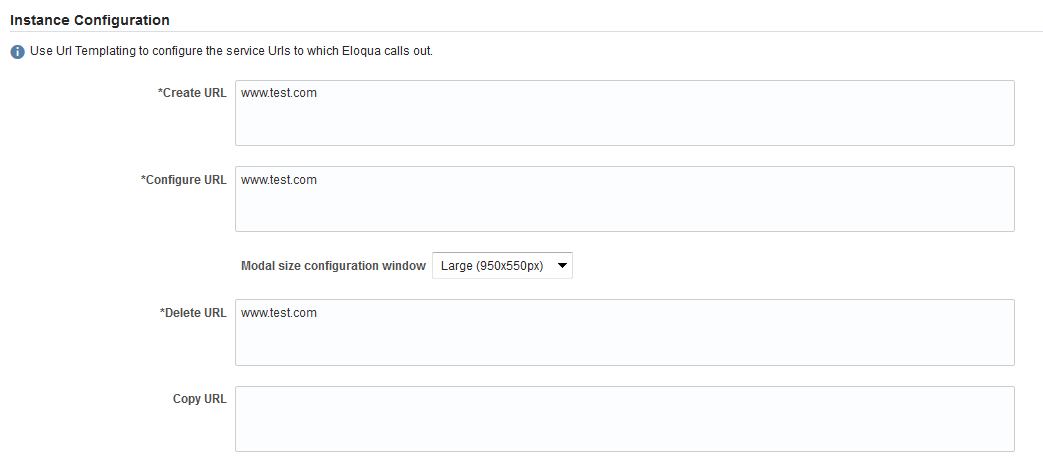Register a feeder service
With feeders, developers can build apps that use data in third-party services to drive campaign membership. When you set up a feeder service, you will need to provide the usual AppCloud developer framework service details, as well as the Instance Configuration and Feeder Settings.
Service Details
These fields are present for all services:
- Name: the name of the service. Max length: 100 characters.
- Description: describes what the service does. Max length: 4000 characters.
- 16x16px Icon: the URL of the icon Eloqua displays when your service is displayed on a canvas. The icon will be 16px by 16px when displayed. It must be a secure URL. See App icon design guidelines for more information on designing app icons.
- 32x32px Icon: the URL of the icon that Eloqua should display for your service. The icon will be 32px by 32px when displayed. It must be a secure URL. See App icon design guidelines for more information on designing app icons.
Instance configuration
This section defines the URLs for creating, configuring, copying, and deleting an instance of your service. The installation tutorial details the instance creation flow when a marketer drags an feeder step onto the canvas, and selects your app.
Each URL is a templated URL that uses common URL template parameters and some Eloqua markup language parameters. Eloqua replaces these paramters with their appropriate values when it makes a call. For more about URL templating, see our Introduction to URL templating.Create URL: A templated URL pointing to a web portal for creating an instance of this service as an HTTP
POSTrequest. All common URL template parameters are available.You should be sure to include, at a minimum, the
{InstanceId}parameter so that you will be able to identify the service in the future. On success, this endpoint should return a 200-level response with the created instance.Configure URL: A templated URL pointing to an endpoint for configuring an instance of this service as an HTTP
GETrequest. All common URL template parameters are available.You should be sure to include, at a minimum, the
{InstanceId}parameter so that you will be able to identify the service in the future.Modal size configuration window: Select a modal size for your configuration window. The configuration page displays when marketers configure your service.
- Large: 950px x 550px
- Small: 650px x 550px
Delete URL: A templated URL pointing to an endpoint for deleting an instance of this service using an HTTP
DELETErequest. All common URL template parameters are available. On success, this endpoint should return a 200-level response.Copy URL: A templated URL pointing to an endpoint for creating an instance of this service as an HTTP
POSTrequest. All common URL template parameters are available in addition to{OriginalInstanceId},{OriginalInstallId},{OriginalAssetId}, and{OriginalAssetName}.You should be sure to include, at a minimum, the
{InstanceId}and{OriginalInstanceId}parameters so that you can identify the original and newly created instances. On success, this endpoint should return a 200-level response with the created instance. Learn how to Respond when a marketer copies a service instance.
Feeder settings
- User Access: Select the Eloqua services for which your app will be available.
-
Notification URL: This URL is called (HTTP
POST) when a campaign containing an instance of the service's status changes, such as when it is activated.Be sure to include the
{AssetId}and{EventType}parameters in the templated URL.AssetIddescribes the campaign whose status has changed, andEventTypedefines the status. When a campaign is activated, for exampleEventTypewill be “Active”. Otherwise, you will not be able to identify what the incoming call references.
When you’re done configuring your service, click Save. A green alert message will appear at the top of the page indicating the service has been successfully saved.

